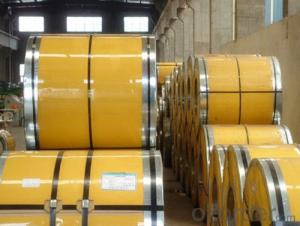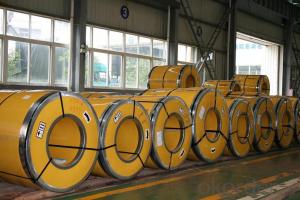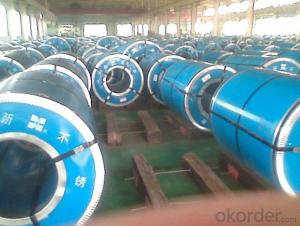Cold Rolled Stainless Steel Strip 304 Serious
- Loading Port:
- Shanghai
- Payment Terms:
- TT OR LC
- Min Order Qty:
- 25 m.t.
- Supply Capability:
- 100000 m.t./month
OKorder Service Pledge
OKorder Financial Service
You Might Also Like
Cold Rolled Stainless Steel Strip 304 Serious
1.Structure of Cold Rolled Stainless Steel Strip 304 Serious
Cold Rolled Stainless Steel Strip 304 Serious is one of the raw material of the cold rolled stainless steel strip, which can be used directly in many places. Stainless Steel (Stainless Steel) is short for acid-proof Stainless Steel, resistant to weak corrosive medium such as air, steam, water, or with a Stainless Steel grade.
2.Main Features of Cold Rolled Stainless Steel Strip 304 Serious
1) weldability: The purpose of the different requirement for welding performance are different.1 Kind of tableware generally do not require the performance of welding, even including some pot class enterprise. But the vast majority of products all need raw materials welding performance is good, like the 2 kinds of tableware, thermos flask, steel pipes, water heaters, water dispensers, etc.
2) Corrosion resistance The vast majority of stainless steel products for corrosion resistant performance is good, like a, 2 kinds of tableware, kitchen utensils and appliances, water heaters, water dispensers, etc., some foreign businessmen on corrosion resistance of products also do experiment: in NACL aqueous solution heated to boiling, after a period of time the best solution, wash and drying, weight loss, to determine the degree of corrosion (note: the product polishing, because of the sand cloth or sandpaper containing Fe, will cause the test surface rust spots)
3) Polishing performance In today's society stainless steel products in production after polishing the process commonly, when only a small number of products such as water heaters, water dispenser tank don't need polishing. So this will require materials polishing performance is very good. The factors influencing polishing performance mainly include the following: 1) raw material surface defects. Such as scratch, pitting, pickling, etc. (2) raw material problem. Hardness is too low, easy when polishing cast light (BQ), and the hardness is too low, the surface easily when deep drawing appear orange peel phenomenon, which affects the BQ. Relatively high hardness of BQ sex is good. (3) after deep drawing products, great deformation area surface will be a small black spots and RIDGING, thus affecting the BQ.
4) Heat resistant performance Heat resistant performance refers to the high temperature stainless steel can still maintain its excellent physical and mechanical properties. Carbon: the influence of carbon in austenitic stainless steel is formed strong and steady. Set the austenitic austenitic area and expand elements. Carbon formation of austenite is about 30 times that of the nickel, the ability of carbon is a kind of gap elements, through the solid solution strengthening can significantly increase the strength of the austenitic stainless steel. Carbon austenitic stainless steel can be improved in high concentration chloride (e.g., 42% MgCl2 boiling solution) in the performance of the resistance to stress corrosion. But, in the austenitic stainless steel, carbon is often seen as the harmful elements, this is mainly due to the corrosion of stainless steel used in some conditions, such as welding or heating by 450 ~ 850 ℃), carbon steel with chromium in forming high chromium Cr23C6 type carbon compounds which can lead to local chromium depletion, make steel corrosion resistance especially resistant to intergranular corrosion performance degradation. So. Since the 60 s of the development of new cr-ni austenitic stainless steel is mostly carbon content less than 0.03% or 0.02% of the ultra-low carbon type
5) Corrosion resistance When the atomic number of no less than 12.5% chromium content in steel, can make the steel electrode potential mutations, the negative potential to the positive electrode potential. To prevent electrochemical corrosion.
3. Cold Rolled Stainless Steel Strip 304 Serious Images
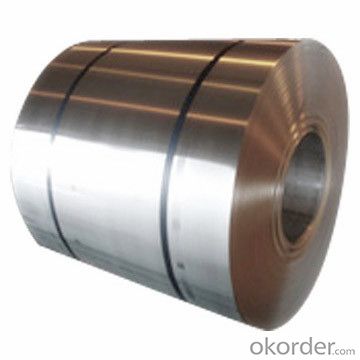
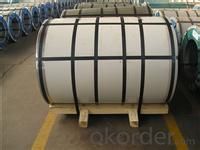
4. Cold Rolled Stainless Steel Strip 304 Serious Specification
The word "stainless steel" is not merely refers to a pure stainless steel, but said more than one hundred kinds of stainless steel industry, the development of each stainless steel has good performance in their specific applications. The key to the success of the first is to make clear purpose, and then determine the correct material. Related to architectural construction applications usually only six types of steel. They contain 17 ~ 22% chromium, good steel contains nickel. Add molybdenum can further improve the atmospheric corrosion resistance, especially containing chloride atmospheric corrosion resistance. Stainless steel often according to the state of organization can be divided into: martensite steel, ferritic steel, austenitic steel, austenitic (two-phase) - ferrite stainless steel and precipitation hardening stainless steel, etc. In addition, according to ingredients can be divided into: chromium stainless steel, chromium nickel stainless steel and chromium manganese nitrogen stainless steel, etc.
1) Ferritic stainless steel Chromium containing 15% ~ 30%. Its corrosion resistance, toughness and weldability with chromium content increases with the increase of chloride stress corrosion resistance is superior to other types of stainless steel, fall into this category of Crl7, Cr17Mo2Ti, Cr25, Cr25Mo3Ti, Cr28, etc. Ferritic stainless steel because of the high chromium content, corrosion resistance and oxidation resistance are relatively good, but the mechanical properties and process performance is poorer, more used to stress less acid structure and steel used as antioxidant. This kind of steel to withstand atmosphere, nitric acid and corrosion of the brine solution, and has good high temperature oxidation resistance, low thermal expansion coefficient, etc, used in nitric acid and food factory equipment, also can make work under high temperature parts, such as gas turbine parts, etc.
2) Austenitic stainless steel The title Chromium is more than 18%, still contain about 8% of the nickel and small amounts of molybdenum, titanium, nitrogen and other elements. Good comprehensive performance, corrosion resistant to a variety of media. Number of austenitic stainless steel is commonly used one cr18ni9, 0 cr19ni9, etc. In the Wc < 0.08% 0 cr19ni9 steel, steel grade is marked as "0". This class contains large amounts of Ni and Cr in steel, make steel in austenitic state at room temperature. This kind of steel has good plasticity and toughness, weldability and corrosion resistance and non-magnetic or weak magnetic, the corrosion resistance in oxidizing and reducing medium are good, used to make acid equipment, such as corrosion resistant containers and equipment lining, pipelines, nitric acid resistant equipment parts, etc., also can be used as the main body of watches and clocks jewelry stainless steel material. Austenitic stainless steel with solid solution treatment, the steel heating to 1050 ~ 1150 ℃, then water-cooled or air-cooled, for single-phase austenitic organization.
3) Austenitic, ferritic duplex stainless steel The advantages of both austenitic and ferritic stainless steel, and has the superplasticity. Austenite and ferrite The title Each accounts for about half of the stainless steel. In the case of contain low C, Cr content was 18% ~ 18%, Ni content at 3% ~ 3%. Some steel containing Mo, Cu, Si, Nb, Ti, N and other alloying elements. This kind of steel both austenite and ferrite stainless steel, the characteristics of compared with ferrite, plasticity and toughness is higher, no room temperature brittleness, intergranular corrosion resistance and welding performance were significantly increased, while maintaining a ferritic stainless steel of 475 ℃ brittleness and high thermal conductivity, has the characteristics of superplasticity. Compared with austenitic stainless steel, high strength and resistance to intergranular corrosion and resistance to chloride stress corrosion is improved obviously. Duplex stainless steel has excellent resistance to pitting corrosion performance, is also a kind of nickel and stainless steel.
4) Precipitation hardening stainless steel For austenitic or martensite structure matrix, and the number of precipitation hardening stainless steel commonly used such as 04 cr13ni8mo2al. It can pass the precipitation hardening (also known as the age hardening) dealing with the hard (strong) of stainless steel.
5) Precipitation hardening stainless steel For austenitic or martensite structure matrix, and the number of precipitation hardening stainless steel commonly used such as 04 cr13ni8mo2al. It can pass the precipitation hardening (also known as the age hardening) dealing with the hard (strong) of stainless steel.
5.FAQ of Cold Rolled Stainless Steel Strip 304 Serious
We have organized several common questions for our clients,may help you sincerely:
①How about your company?
A world class manufacturer & supplier of castings forging in carbon steel and alloy steel,is one of the large-scale professional investment casting production bases in China,consisting of both casting foundry forging and machining factory. Annually more than 8000 tons Precision casting and forging parts are exported to markets in Europe,
②How to guarantee the quality of the products?
We have established the international advanced quality management system,every link from raw material to final product we have strict quality test;We resolutely put an end to unqualified products flowing into the market. At the same time, we will provide necessary follow-up service assurance.
③How is the chemical compositon?
304 chemical composition:
C ≤ 0.08, Si ≤ 0.075, Mn ≤ 2.00, P ≤ 0.04, S ≤ 0.03, Ni :8.0-11.0, Cr :18.0-20.0
- Q:What are the dimensions and thickness ranges available in 111 stainless steel strips?
- The dimensions and thickness ranges of 111 stainless steel strips differ based on the manufacturer and supplier. Nevertheless, there are commonly accessible choices for 111 stainless steel strips, comprising thicknesses between 0.1mm and 3.0mm, and widths between 10mm and 600mm. To ascertain the precise dimensions and thickness ranges provided by a particular manufacturer or supplier for 111 stainless steel strips, it is crucial to seek consultation with them.
- Q:Are stainless steel strips suitable for jewelry making?
- Yes, stainless steel strips are suitable for jewelry making. Stainless steel is a durable and versatile material that is resistant to tarnishing, rust, and corrosion, making it an excellent choice for jewelry that is meant to last. It is also hypoallergenic, making it suitable for individuals with sensitive skin or metal allergies. Stainless steel strips can be easily shaped and manipulated into various jewelry designs, including rings, bracelets, necklaces, and earrings. Additionally, stainless steel is often used as an alternative to more expensive metals like silver or gold, offering a more affordable option for those who still desire high-quality jewelry.
- Q:What are the different types of edges for stainless steel strips?
- The different types of edges for stainless steel strips include mill edge, slit edge, deburred edge, and rounded edge.
- Q:Are stainless steel strips resistant to corrosion?
- Yes, stainless steel strips are highly resistant to corrosion due to the presence of chromium which forms a protective oxide layer on the surface, preventing the metal from rusting or corroding.
- Q:How do you measure the thickness of stainless steel strips?
- One way to measure the thickness of stainless steel strips is by using a micrometer. This handheld device allows for precise measurements by gently clamping the strip between its jaws and reading the measurement displayed on the micrometer's scale.
- Q:How does stainless steel strip perform in corrosive environments?
- Stainless steel strip performs exceptionally well in corrosive environments. Due to its high chromium content, stainless steel forms a protective oxide layer on its surface when exposed to oxygen, which prevents the material from further corrosion. This oxide layer acts as a barrier against corrosive elements such as moisture, chemicals, and saltwater, providing stainless steel strip with excellent resistance to corrosion. Furthermore, stainless steel strip exhibits superior corrosion resistance to various acids, alkaline solutions, and organic compounds, making it an ideal choice for applications in industries such as chemical processing, food processing, and marine environments. Its resistance to pitting corrosion and crevice corrosion further enhances its performance in corrosive environments. In addition to its corrosion resistance, stainless steel strip also possesses other beneficial properties such as high strength, durability, and heat resistance, making it a reliable material for a wide range of applications. Whether used for manufacturing equipment, components, or structures, stainless steel strip offers long-lasting performance, even in harsh and corrosive conditions.
- Q:Can stainless steel strips be used in marine applications?
- Indeed, the utilization of stainless steel strips in marine applications is possible. The exceptional corrosion resistance of stainless steel renders it a perfect choice for marine settings, where it endures constant exposure to saltwater and moisture. In marine applications, such as boat hardware, marine fittings, and structural components, stainless steel strips are frequently employed. These strips are specifically engineered to endure the rigorous conditions of the sea, including elevated levels of salt, humidity, and UV exposure. Moreover, stainless steel strips exhibit remarkable strength and durability, guaranteeing their ability to endure the challenging conditions of marine environments for an extended duration.
- Q:How do stainless steel strips handle thermal expansion and contraction?
- The remarkable ability of stainless steel strips to handle thermal expansion and contraction is well-known. This is due to stainless steel's highly stable and resilient nature, which enables it to withstand significant temperature changes without distortion or damage. Stainless steel strips gradually and uniformly expand when exposed to heat, allowing them to maintain their shape and structural integrity. This expansion is relatively minimal compared to other metals, reducing the risk of warping or buckling. Similarly, when subjected to cold temperatures, stainless steel strips contract evenly, ensuring they can adapt to changing conditions without compromising their strength. The outstanding thermal expansion and contraction properties of stainless steel strips make them suitable for various applications, especially those involving temperature fluctuations. Industries such as construction, automotive, aerospace, and manufacturing commonly use stainless steel for structural components, fasteners, and heat exchangers. However, it is important to note that while stainless steel is highly resistant to thermal expansion and contraction, it is not entirely immune to extreme temperature changes. Proper engineering and design considerations should always be taken into account to optimize the material's performance and minimize potential issues.
- Q:What are the different cutting methods for stainless steel strips?
- There are several cutting methods for stainless steel strips, including shearing, laser cutting, waterjet cutting, and abrasive cutting. Each method has its own advantages and limitations, depending on factors such as the thickness of the strip, desired precision, and production volume.
- Q:What are the main stainless steel belt used in the industry and products?
- It is one of the earliest fields of stainless steel application. In architectural decoration, at present, stainless steel is mainly used in high-rise building exterior wall, indoor and external column coating, handrails, floors, elevator panels, doors and windows, curtain walls and other interior decoration and components. After the surface treatment, coloring and coating of the stainless steel plate, the utility model solves the problems such as fingerprint easily appearing after touching, and further expands the application range of the stainless steel.In the home appliance industry, the large quantities of stainless steel are the inner cylinder of the automatic washing machine, the inner liner of the water heater, the inner and outer shell of the microwave oven and the lining of the refrigerator, and the ferritic stainless steel is adopted.
1. Manufacturer Overview |
|
|---|---|
| Location | |
| Year Established | |
| Annual Output Value | |
| Main Markets | |
| Company Certifications | |
2. Manufacturer Certificates |
|
|---|---|
| a) Certification Name | |
| Range | |
| Reference | |
| Validity Period | |
3. Manufacturer Capability |
|
|---|---|
| a)Trade Capacity | |
| Nearest Port | |
| Export Percentage | |
| No.of Employees in Trade Department | |
| Language Spoken: | |
| b)Factory Information | |
| Factory Size: | |
| No. of Production Lines | |
| Contract Manufacturing | |
| Product Price Range | |
Send your message to us
Cold Rolled Stainless Steel Strip 304 Serious
- Loading Port:
- Shanghai
- Payment Terms:
- TT OR LC
- Min Order Qty:
- 25 m.t.
- Supply Capability:
- 100000 m.t./month
OKorder Service Pledge
OKorder Financial Service
Similar products
New products
Hot products
Hot Searches
Related keywords

